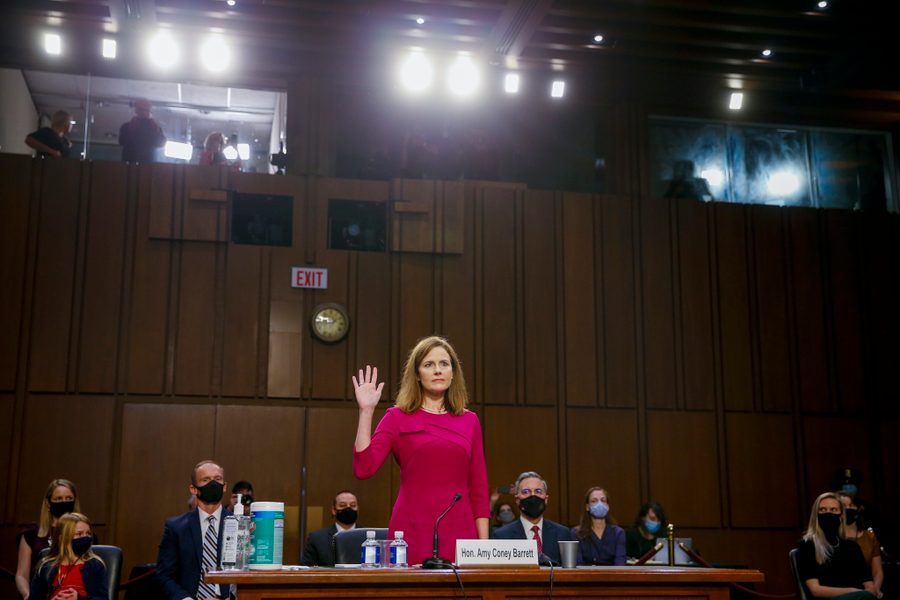
Who would have thought that in one of the world’s oldest democracies, the lifetime appointment of a single jurist, to be decided by a simple senatorial majority, could rival in significance the decision of more than 150 million citizens choosing their president at the ballot box? For liberals and progressives, the frustration is palpable, and fully justified. Over the course of a few hours, veneration of Ruth Bader Ginsburg’s distinguished service to the nation was followed by trepidation and a gnashing of teeth over Mitch McConnell’s determination to fill her place before the expiration of Trump’s term.
The nomination of Antonin Scalia mentee Amy Coney Barrett further fanned the flames. Even as public opinion has clearly swung to the left on policy issues over recent years — not only for Obamacare-plus health coverage but also in regarding a wealth tax and limits on private and corporate political contributions — conservative control of the judiciary, beginning with the Supreme Court, threatens to block or even to roll back any democratic legislative advance.
It is little solace that some liberal legal experts, like Harvard Law School’s Noah Feldman who testified before the House Judiciary Committee on behalf of President Trump’s impeachment, not only excuses but welcomes a candidate like Barrett because she passes a meritocratic test internal to the legal profession. “I disagree with much of her judicial philosophy,” Feldman wrote in Bloomberg on September 26, “and expect to disagree with many, maybe even most, of her future votes and opinions. Yet despite this disagreement, I know her to be a brilliant and conscientious lawyer who will analyze and decide cases in good faith, applying the jurisprudential principles to which she is committed.”
What are the likely outcomes of such thinking for the American people? Chief Justice John Roberts’ court already has curtailed the application of previous voting rights acts (Shelby County v. Holder), struck down restrictions on the flow of corporate or unacknowledged private funding in political campaigns (Citizens United), and denied the right of class action lawsuits in the case of claims of wage theft from non-union workers (Epic Systems Corp v. Lewis).
The narrowly “textualist” and “originalist” principles to which Barrett subscribes, inevitably carry conservative political implications. From such a mindset, any legislation that would expand health insurance, union rights, environmental regulation, as well as abortion access is likely in deep trouble. For Feldman, however, Barrett’s “views about how to interpret the law that I think are wrong and, in certain respects, misguided” are more than balanced by her being among the best and brightest in her cohort. Ah, if only we could use the LSATs to choose all our federal officials!
What steps might a Democratic Congress, take in 2021 to protect the country from a judicial super-majority defined by Justices Roberts, Alito, Thomas, Gorsuch, Kavanaugh, and Barrett? Most journalistic commentary has centered on “court-packing” ideas harkening back to President Franklin Roosevelt’s ultimately foiled attempt in 1937 to expand the court from nine to as many as fifteen justices to prevent its undoing his entire New Deal program. This was (and remains) a messy solution, for it turns public scrutiny from an undemocratic, reactionary judicial branch to a seemingly overreaching executive authority.
In FDR’s case, historians suggest, the mere threat of radical judicial surgery proved enough to temper the impulse towards judicial review, and for decades the court largely refrained from countermanding major economic law-making by state and federal legislative majorities. On the other hand, the bitter political after-taste from the court-packing fight helped to fuel a Republican resurgence in Congressional elections to come.
But historical antecedents to the court-packing plan offer other keys to a still-useable past. By the 1920s, the Supreme Court had truly become a bulwark of corporate privilege, acting against limitations on union blacklisting in Kansas in 1915, overturning the federal child labor law in 1918, and throwing out a minimum wage for women workers in Washington D.C. in 1923. Chief Justice and ex-President William Howard Taft (1921−1930) cheered on such moves by openly railing against “socialist raids upon property rights.”
As the courts increasingly detached themselves from public opinion on key issues of national welfare, they came under increasing criticism from progressive circles. Indeed, with a focus on mis-use of injunctions and contempt citations in labor disputes, Theodore Roosevelt’s Progressive Party in 1912 prioritized “restriction of the power of the courts as shall leave to the people the ultimate authority to determine fundamental questions of social welfare and public policy.” The Socialist Party led by Eugene V. Debs went further, advocating a constitutional amendment to abolish judicial review of legislative acts altogether.
Two tangible national reform ideas followed in the next decade. As documented by historian Steven F. Lawson, Wisconsin’s Progressive Senator Robert “Fighting Bob” La Follette introduced a constitutional amendment in 1922 (never put to a Congressional vote) whereby Congress would have the right to re-enact –and thus enact for good — any law ruled unconstitutional by the Supreme Court. In the same year, Republican Sen. William Borah of Idaho proposed a different reform tack: hoping to restrict judicial review to only the most egregious violations of individual rights, his plan required any judicial override by the Supreme Court to carry at minimum a 7 to 2 court majority.
Beyond grappling with a single Supreme Court appointment, it behooves today’s progressives to challenge all those still infected by what the eminent judicial biographer Alpheus Mason in 1958 labeled the “cult of the judicial robe.” As La Follette aptly warned, “[Should the Court keep] the final and conclusive authority to determine what laws Congress may pass, then, obviously, the Court is the real ruler of the country exactly the same as the absolute King would be.”
Should Amy Coney Barrett succeed to the Supreme Court and the Democrats retake the Senate in the November elections, the New Democratic Congress should quickly pass a campaign finance act on the order of what was overturned by the Citizens United decision. That will set up a test — as was the National Labor Relations Act for the New Dealers — of whether the Court had learned its proper democratic lesson.
If the Court again asserts its dominance over the nature of our electoral system by overturning such a law, then Congress should move to Sen. Borah’s revised-court-majority idea. Such a change would by itself take the sting from a right-wing majority. If and when the Court also rules such an act unconstitutional, then it is surely time to take FDR’s court-packing plan out of mothballs.

I hope you found this article important. Before you leave, I want to ask you to consider supporting our work with a donation. In These Times needs readers like you to help sustain our mission. We don’t depend on—or want—corporate advertising or deep-pocketed billionaires to fund our journalism. We’re supported by you, the reader, so we can focus on covering the issues that matter most to the progressive movement without fear or compromise.
Our work isn’t hidden behind a paywall because of people like you who support our journalism. We want to keep it that way. If you value the work we do and the movements we cover, please consider donating to In These Times.






